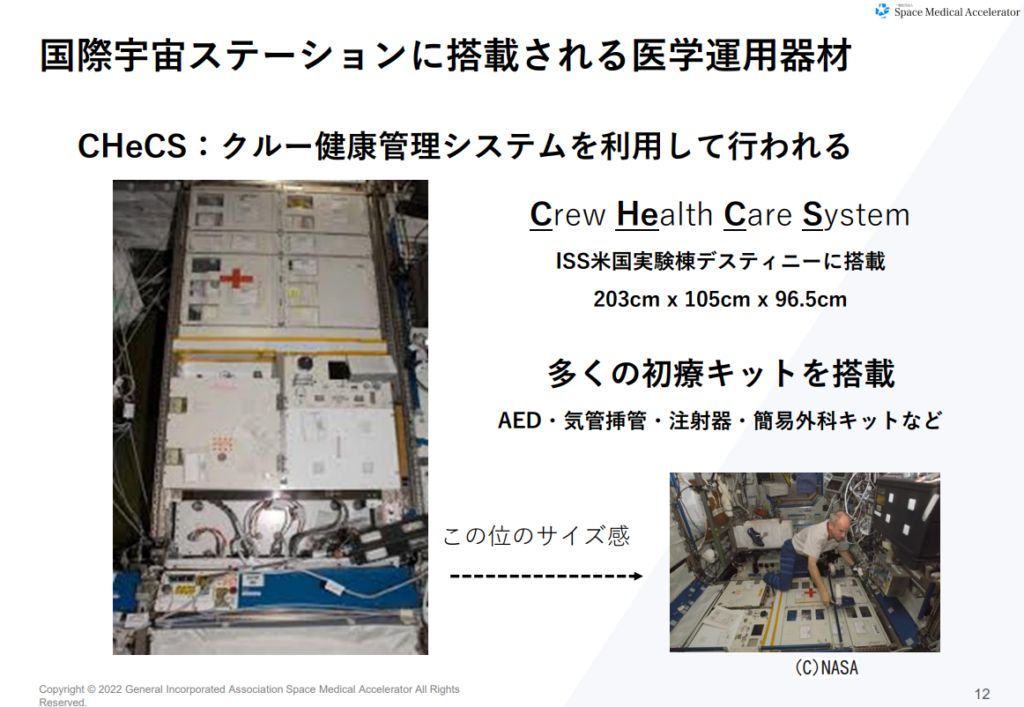Lecture at the 30th Japanese Society for Cardiac Rehabilitation ‘Space Medicine x Rehabilitation’

Hello, I am Space Medical Accelerator (SMA) representative and neurosurgeon Goto.
From now, we would like to begin the transmission of the latest findings on SMA activities and space medicine on the blog.
This time, I would like to talk about what I discussed at the symposium session ‘Space Medicine x Rehabilitation’ at the 30th Japanese Society of Cardiac Rehabilitation held in Kobe on 13 July 2024.
Heart specialists, i.e. cardiologists and therapists, have a high interest in space medicine, and a symposium on space medicine was also held at the Annual Meeting of the Japanese Society of Cardiology in 2023.
We had a very large audience again, so I will share what we talked about.
1.Medical treatment currently practiced in space
First, I explained the medical care currently provided on the International Space Station (ISS).
The main medical problems that occur in space can be divided into three environmental factors: (1) microgravity, (2) space radiation (3) closed space.
I also talked about the resistance exercise and aerobic exercise using special equipment that astronauts on the ISS currently perform for two hours a day, six times a week to maintain their physical functions, including how ground-based exercise equipment has been improved for use in a microgravity environment.
Next, as this is also a rehabilitation conference, I talked about recovery programmes after returning to the ground. Although it is well known that astronauts undergo rehabilitation after their return to Earth, the details and aims of this rehabilitation programme may not be well known.
There are two physical characteristics of astronauts immediately after returning from a stay in space.

The first is difficulty in maintaining posture. On Earth, humans recognize their body position and maintain posture by integrating information from the visual, vestibular and somatosensory senses, but after a long stay in microgravity, the vestibular and somatosensory senses change, and it becomes difficult to maintain posture and walk because these senses cannot be integrated properly immediately after return.
Another is a clear decrease inflexibility, such as long-sitting forward bending, and in agility and mobility, such as the time taken to run between cones. Aerobic capacity is also reduced by 15% before and after the flight.
Therefore, I talked about how the programme is designed to restore the ability to control posture, which is taken for granted on the ground, as well as flexibility and body coordination exercises.
<Physical characteristics after prolonged stay in microgravity>
(1) Prolonged stay in microgravity alters vestibular and somatosensory perception, making it difficult to maintain posture and walk due to the inability to integrate these senses immediately after return
(ii) Flexibility, agility and mobility are clearly reduced

The talk then moved on to medical kits and equipment used on the ISS, including a medical rack the size of a payphone box on the ISS’s US laboratory module Destiny and a small ultrasound (echo) device, considered the most useful medical equipment in space, with examples of actual use. The talk was accompanied by references to the literature.
2.Physiological changes in the cardiovascular system in space

Next, the physiological changes in the human body when entering microgravity were discussed, focusing mainly on the circulatory system.
It is well known that when a person enters microgravity, a ‘fluid shift’ occurs, in which approximately 2 litres of water (e.g. blood) moves towards the head, causing the face to become round and the legs to become thin.
This is sometimes referred to as moon face or chicken legs, but there is also a feeling of a stuffy nose.
The resulting increase in blood in the thoracic cavity (which stimulates capacitance receptors in the aortic arch and other parts of the body to determine that there is an excess of fluid) inhibits the secretion of anti-diuretic hormone (ADH).
It is also believed that the secretion of atrial Na-diuretic peptide (ANP) hormone in atrial myocytes is stimulated, causing diuresis and a reduction in blood and fluid volume to reach equilibrium (in fact, blood volume is reduced by more than 10 % after a few weeks in space).
However, there is no proof that diuresis really occurs in space, and it has been suggested that it may be due to a negative water balance caused by reduced water intake.
Also, when diuresis occurs due to fluid shifts, the blood becomes temporarily concentrated.
If this remains the case, the blood is sluggish and blood circulation becomes slow and blood clots can easily form, so the red blood cell count is destroyed to dilute the blood, resulting in the concentrated blood returning to its original state and being diluted.
However, the body as a whole will have a reduced blood volume, a condition known as ‘space anaemia’. This situation can be said to be the result of the body adapting to the weightless environment.
After one month in space, the body loses about 8% of its blood, after two months about 13% and after three months about 16%, and the body weight is reduced by that amount.
Furthermore, it has recently been found that during spaceflight, the hormone erythropoietin, which causes the production of new red blood cells, is produced in excess.
This indicates that the lysis of red blood cells that persists throughout the space mission, i.e. ‘space quality blood’, gets worse the longer the stay in space is prolonged.
As anaemia is closely related to physical ailments such as fatigue and dizziness, it will be necessary to monitor this ‘space anaemia’ reliably in the future.
< Microgravity-induced changes to the cardiovascular system>
1: Diuresis occurs and blood is temporarily concentrated.
2: Concentrated blood becomes diluted (space anaemia).
3: Space anaemia worsens the longer the stay in space is prolonged.
3.Relationship between human effects in space and the passage of time

Finally, the relationship between the effects of the space environment on the human body and changes over time is explained.
The diagram above is a well-known diagram showing the effects of the space environment on the circulatory system and various other organs of the body, with ‘time’ on the horizontal axis.
The bottom line should be seen as the state of adaptation to the Earth environment, the next line as adaptation to the space environment and the uppermost line as a state requiring treatment.
The body fluids and electrolytes such as sodium shown by the green line, the cardio-circulatory system shown by the red line and the red blood cell volume shown by the purple line are adapted to the space environment after approximately 1.5 months of stay.
(This reaction occurs in reverse and takes a similar length of time when returning from a long stay.)
It is important to note that there are two factors that do not reach an equilibrium point and have a linearly increasing effect.
One is bone and calcium metabolism in the solid black line, which causes linear atrophy of the musculoskeletal system if no action is taken.
The other is cosmic radiation (black dashed line), the effects of which accumulate in proportion to the duration of stay.
It is important to understand that some functions of the human body can naturally adapt to the space environment, while others cannot.

This is a brief but brief summary of my presentation about the recent cardiac rehabilitation conference.
We will continue to send out brief summaries like this when we speak at conferences and events.
Please keep an eye on the activities of the Space Medical Accelerator!
Reference
- Long-term spaceflight and the cardiovascular system. Precision Clinical Medicine, 2020. https://doi.org/10.1093/pcmedi/pbaa022
- Incidence Rate of Cardiovascular Disease End Points in the National Aeronautics and Space Administration Astronaut Corps. J Am Heart Assoc, 2017. doi: 10.1161/JAHA.117.005564
- JAXA有人宇宙技術部門 医学運用チームの仕事
- Venous Thrombosis during Spaceflight. NEJM, 2020. Venous Thrombosis during Spaceflight (sci-hub.se)
- Space Physiology and Medicine 3rd Edition, 1993
- Hemolysis contributes to anemia during long-duration space flight. Nature Medicine, 2022. https://www.nature.com/articles/s41591-021-01637-7
- 宇宙(フライト)貧血 Astronaut Anemia, SpaceFlight-related Anemia. JAXA宇宙教育センター 教材3 003.pdf (jaxa.jp)


